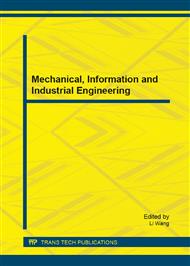[1]
K.J. Anil: Pattern Recognition Letters, Vol. 31 (2010), pp.651-666.
Google Scholar
[2]
R. Xu, D.C. Wunsch II: IEEE Trans. Neural Netw. , Vol. 16 (2005), p.645–678.
Google Scholar
[3]
D. Aloise, A. Deshpande, P. Hansen, et al.: Machine Learning, Vol. 75 (2009), pp.245-248.
Google Scholar
[4]
M. Meila, in: Proc. 23rd Internat. Conf. Machine Learning (2006), p.625–632.
Google Scholar
[5]
K.J. Anil, R.C. Dubes: Algorithms for Clustering Data, Prentice Hall R.J. Ong, J. T (1988).
Google Scholar
[6]
R. Tibshirani, G. Walther and T. Hastie: J. Roy. Statist. Soc. B (2001), p.411–423.
Google Scholar
[7]
G. Ball and D. Hall: Behav. Sci., Vol. 12 (1967), p.153–155.
Google Scholar
[8]
M. Figueiredo, A.K. Jain: IEEE Trans. Pattern Anal. Machine Intell. , Vol. 24 (2002), p.381–396.
Google Scholar
[9]
D. Aloise, A. Deshpande, P. Hansen, et al.: Machine Learning, Vol. 75 (2009), pp.245-248.
Google Scholar
[10]
C. Rasmussen: Adv. Neural Inform. Process. Systems, Vol. 12 (2000), p.554–560.
Google Scholar
[11]
L. Kaufman and P. Rousseeuw: Finding Groups in Data: An Introduction to Cluster Analysis, Wiley (1990).
Google Scholar
[12]
J. Peña, J. Lozano and P. Larrañaga: Pattern Recognit. Lett., Vol. 20 (1999), p.1027–1040.
Google Scholar
[13]
P. Bradley and U. Fayyad: in Proc. 15th Int. Conf. Machine Learning (1998), p.91–99.
Google Scholar
[14]
A. Likas, N. Vlassis and J. Verbeek: Pattern Recognit., Vol. 36 (2003), p.451–461.
Google Scholar
[15]
K. Krishna and M. Murty: IEEE Trans. Syst., Man, Cybern., Vol. 29 (1999), p.433–439.
Google Scholar
[16]
C. Chinrungrueng and C. Séquin: IEEE Trans. Neural Netw., Vol. 6 (1995), p.157–169.
Google Scholar
[17]
G. Patanè and M. Russo: Neural Netw., Vol. 14 (2001), p.1219–1237.
Google Scholar
[18]
T. Grigorios and L. Aristidis: Pattern Recognition Letters, Vol. 47 (2014), pp.2505-2516.
Google Scholar
[19]
J. Mao, A.K. Jain: IEEE Trans. Neural Networks, Vol. 7 (1996), p.16–29.
Google Scholar
[20]
Y. Linde, A. Buzo and R. Gray: IEEE Trans. Comm., Vol. 28 (1980), p.84–94.
Google Scholar
[21]
H. Kashima, J. Hu, et al., in: Proc. Internat. Conf. on Pattern Recognition (2008), p.1–4.
Google Scholar
[22]
A. Banerjee, S. Merugu, et al.: J. Machine Learn. Res., Vol. 6 (2005), p.1–48.
Google Scholar
[23]
V. Estivill-Castro and J. Yang: in Proc. 6th Pacific Rim Int. Conf. Art. Int. (PRICAI'00) (2000), p.208–218.
Google Scholar
[24]
E. Backer: Cluster Analysis by Optimal Decomposition of Induced Fuzzy Sets, Delft University Press (1978).
Google Scholar
[25]
M. Steinbach, G. Karypis and V. Kumar: A comparison of document clustering techniques. In: KDD Workshop on Text Mining (2000).
Google Scholar
[26]
D. Pelleg and A. Moore: Accelerating exact k-means algorithms with geometric reasoning. Proc. 5th Internat. Conf. on Knowledge Discovery in Databases (1999), p.277–281.
DOI: 10.1145/312129.312248
Google Scholar
[27]
P.S. Bradley, U. Fayyad and C. Reina: Scaling clustering algorithms to large databases. In: Proc. 4th KDD (1998).
Google Scholar
[28]
D. Pelleg and A. Moore, in: Proc. 17th Internat. Conf. on Machine Learning (2000). p.727–734.
Google Scholar
[29]
L. Kaufman and P.J. Rousseeuw: Finding groups in data: An introduction to cluster analysis. Wiley series in Probability and Statistics (2005).
Google Scholar
[30]
B. Scholkopf, A. Smola, et al.: Neural Comput. , Vol. 10 (1998), p.1299–1319.
Google Scholar


